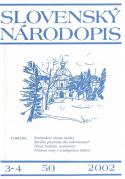ÚSTNA HISTÓRIA VO VYTVÁRANÍ HISTORICKEJ PAMÄTI (KTO, PREČO, AKO NA SLOVENSKO -DOTERAZ A V BUDÚCNOSTI)
ORAL HISTORY AT CREATING HISTORICAL MEMORY (WHO, WHY AND HOW IN SLOVAKIA - UNTIL NOW AND IN FUTURE)
Author(s): Hana HlôškováSubject(s): Customs / Folklore, Oral history, Recent History (1900 till today), 19th Century, Politics of History/Memory
Published by: Ústav etnológie a sociálnej antropológie Slovenskej akadémie vied
Keywords: historical memory; oral historical tradition; history of research; Slovakia;
Summary/Abstract: The pictures of the past, structured into stone or their commencements present substantial factor in constructing and justifying individual or group identity. They are also ascribed high idea or even propaganda potential in relation to future aspiration of the society. They are used for manipulation in politics, publicism and science. They are part of historical memory, where they create specific source of social memory and are used for interpretation or re-interpretation depending on declared or spontaneous mental needs of the society. Author regards historical memory as one part of collective memory. Historical memory of community on a certain level of integration and degree of contemporaneous nation consists of two relatively independent elements the official and unofficial. The first constituent is historiography, political and ideological manipulation with historical facts and artistic literature. The other component is historical consciousness, very often in a form of oral narratives. Nevertheless, they reflect also knowledge, feelings and opinions influenced and formed by the first component. Both components are in a mutual interaction, moreover often even in opposition, and the unofficial historical memory is very often an alternative interpretation of historical events. In the end the of the 20th century dynamics of economic-political changes with constitutional consequences has accelerated the revaluation of history in the Slovak society, although this phenomenon of historicism is characteristic for other countries of Central and Eastern Europe. The aftermath of the World War II can be characterized as mono-thematic considering the interest in prosaic historical traditions. Scientists concentrated usually on one motif cycle. In the beginning of the 90’s the issue of historical memory was “opened” (not only in folklorists but also in historiography, moreover in this field even turbulently). New taboo or marginal themes, which were "smoldering" in the unofficial mentory and ignored by folklorists, came in forefront Namely by means of memorates - memory narration from life, in the beginning of the 90s in Slovakia, folkloristics through oral history method became inspirational for allied sciences-sociology, historiography The research and interpretation of oral historical tradition shall in connection with gathered text material and present study of this issue, concentrate on these problems: creating catalogue of legend material with historical themes; studying inter-genre overlapping; characterization of legend cycles, which have not been researched on yet; inter traditions; question of the representative of historical memory; relations and influences of official and unofficial historical memory; analysis of forms and functions of historical memory within literary folklore; milestones, revolutionary events, personalities and their image in historical memory of their contemporaries (establishing agriculture co-operatives- JRD, constructions of youth, A. Dubček, 21. August 1968. 17. November 1989); materialization of remembrance (photo, video, souvenirs as “triggers" of remembrance) cycles of group memory - history of an employee, confession and interest groups.
Journal: Slovenský národopis
- Issue Year: 50/2002
- Issue No: 3(4)
- Page Range: 353-363
- Page Count: 11
- Language: Slovak

